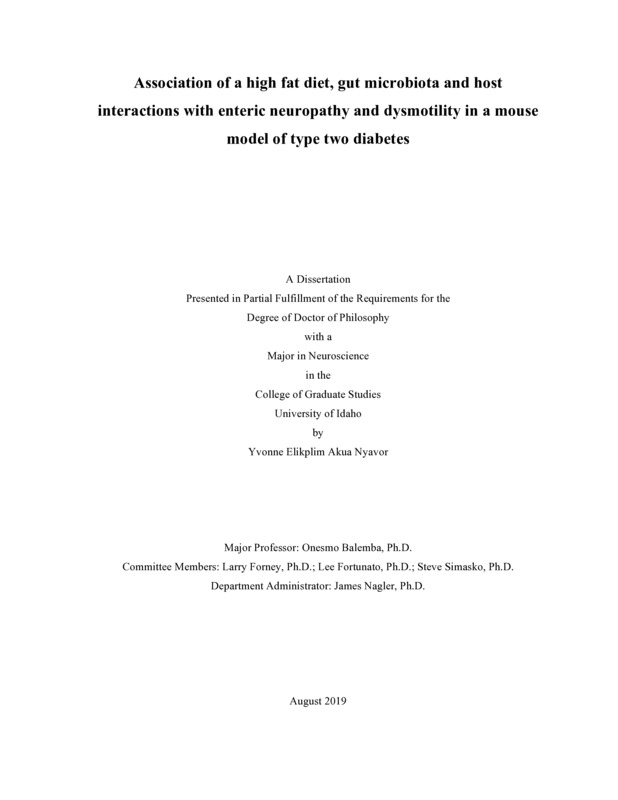Association of a high fat diet, gut microbiota and host interactions with enteric neuropathy and dysmotility in a mouse model of type two diabetes
Nyavor, Yvonne Elikplim Akua. (2019-07). Association of a high fat diet, gut microbiota and host interactions with enteric neuropathy and dysmotility in a mouse model of type two diabetes. Theses and Dissertations Collection, University of Idaho Library Digital Collections. https://www.lib.uidaho.edu/digital/etd/items/nyavor_idaho_0089e_11690.html
- Title:
- Association of a high fat diet, gut microbiota and host interactions with enteric neuropathy and dysmotility in a mouse model of type two diabetes
- Author:
- Nyavor, Yvonne Elikplim Akua
- ORCID:
- 0000-0002-7559-3803
- Date:
- 2019-07
- Keywords:
- enteric nervous system gastroenterology gut microbiome high fat diet mouse type 2 diabetes
- Program:
- Biology
- Subject Category:
- Neurosciences; Physiology; Microbiology
- Abstract:
-
Type 2 diabetes is associated with gut microbiota alterations and debilitating gastrointestinal illnesses caused by neuropathy of the enteric nervous system and smooth muscle dysfunction. However, the specific triggers of enteric neuropathy and muscle dysfunction, and the role of gut microbiota alterations are not fully understood. We studied the specific roles played by gut microbiota alterations in the development of enteric neuropathy using germ free and conventionally raised high fat mouse models. We then studied gut microbiota, myenteric inhibitory neurons and intestinal dysmotility in these mice using next generation sequencing, tissue culture, immunohistochemistry, transmission electron microscopy, ex vivo gastrointestinal motility assays and intracellular microelectrode recording in smooth muscle cells. Conventionally raised male mice became obese, and had impaired glucose tolerance and insulin resistance after 4 weeks of high fat diet (HFD) ingestion. Conventionally raised female mice were however resistant to the weight gain, impaired glucose tolerance, and insulin resistance induced by HFD ingestion even after 8 weeks. Despite these differences, after 8 weeks, conventionally raised male and female mice fed a HFD had slower intestinal propulsive motility. These mice had microbiota alterations marked by increased gram-positive Firmicutes and lower Gram-negative Bacteroidetes. In addition, they had fewer numbers of neurons per ganglion, lower numbers of myenteric inhibitory neurons, and axonal damage including swelling and loss of cytoskeletal filaments. HFD ingestion also impaired inhibitory neuromuscular transmission in both genders.
To determine the role of HFD-microbiota-host interactions in HFD-induced enteric neuropathy and dysmotility, filtrates of luminal contents from the ileum and cecum (hereafter, ileocecal supernatants) of both conventionally raised male and female HFD fed mice were superfused into the lumen of isolated intestinal segments or applied on cultured duodenal or distal colon muscularis preparations. Ileocecal supernatants inhibited intestinal propulsive motility and muscularis contractions. We then used solid phase extraction to separate ileocecal supernatants into water-soluble and methanol (20%, 50% and 100%) soluble fractions and tested them in motility assays. Like the ileocecal supernatants, the water fraction from HFD mice inhibited intestinal propulsive motility and blocked muscularis contractions. HFD Supernatants and water fractions also caused loss of myenteric nitrergic neurons and inflammation. They damaged smooth muscle and impaired neuromuscular transmission in cultured muscularis preparations. Supernatants and water fractions blocked the discharge of spontaneous slow waves and action potentials, the electrical activities underlying contractions of smooth muscle cells. These effects matched the effect of HFD ingestion on the excitability of smooth muscle cells in distal colon.
To determine the role of an intact gut microbiota in the development of enteric neuropathy, we used a germ free HFD mouse model. We found that compared to conventionally raised mice, HFD ingestion did not reduce the number of myenteric inhibitory neurons in the duodenum of germ free mice. HFD also induced alterations in the cecum of conventionally raised mice, which led to increased gram-positive bacteria. Subsequent studies revealed that lipoteichoic acid from gram-positive bacteria induced a loss of myenteric nitrergic neurons associated with oxidative stress and inflammation. Taken together, these studies provide new evidence to support the hypothesis that diet-microbiota-host interactions play a crucial role in the development of enteric neuropathy and dysmotility in a high fat diet mouse model of type 2 diabetes.
- Description:
- doctoral, Ph.D., Biology -- University of Idaho - College of Graduate Studies, 2019-07
- Major Professor:
- Balemba, Onesmo B
- Committee:
- Forney, Larry J; Fortunato, Elizabeteh; Simasko, Steve
- Defense Date:
- 2019-07
- Identifier:
- Nyavor_idaho_0089E_11690
- Type:
- Text
- Format Original:
- Format:
- application/pdf
- Rights:
- In Copyright - Educational Use Permitted. For more information, please contact University of Idaho Library Special Collections and Archives Department at libspec@uidaho.edu.
- Standardized Rights:
- http://rightsstatements.org/vocab/InC-EDU/1.0/

